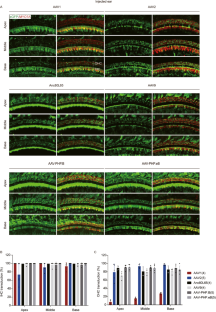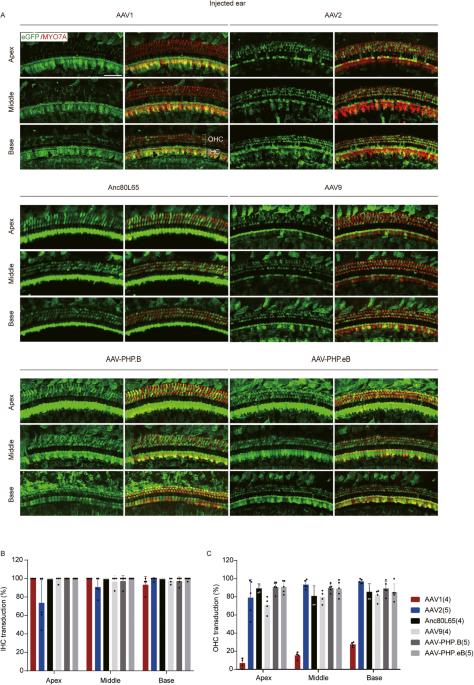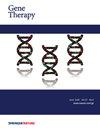单侧耳蜗给药后不同 AAV 向量的分布比较
IF 4.5
3区 医学
Q1 BIOCHEMISTRY & MOLECULAR BIOLOGY
引用次数: 0
摘要
腺相关病毒(AAV)基因疗法已广泛应用于耳聋小鼠模型。但是,由于 AAV 对细胞类型的特异性较低,其在内耳传递后可能转导非靶器官。本研究比较了AAV1、AAV2、Anc80L65、AAV9、AAV-PHP.B和AAV-PHP.eB在新生小鼠圆窗膜(RWM)注射后的转基因表达和生物分布。在注射的耳蜗中检测到的病毒浓度最高。AAV2、Anc80L65、AAV9、AAV-PHP.B和AAV-PHP.eB能高效转导内毛细胞和外毛细胞,而AAV1转导内毛细胞的效率高,但转导外毛细胞的效率低。与注射耳蜗相比,所有 AAV 亚型都能有限地转导对侧内耳、大脑、心脏和肝脏。在大多数脑区,AAV1 和 AAV2 的增强型绿色荧光蛋白(eGFP)表达量低于其他四种亚型。通过染色追踪试验,我们认为耳蜗导水管可能是载体从耳蜗瞬间渗入大脑的途径之一。总之,我们的研究结果为进一步研究载体通过内耳局部注射的生物分布提供了可用数据,并为选择用于耳聋基因治疗的AAV血清型提供了参考。本文章由计算机程序翻译,如有差异,请以英文原文为准。


Distributional comparison of different AAV vectors after unilateral cochlear administration
The adeno-associated virus (AAV) gene therapy has been widely applied to mouse models for deafness. But, AAVs could transduce non-targeted organs after inner ear delivery due to their low cell-type specificity. This study compares transgene expression and biodistribution of AAV1, AAV2, Anc80L65, AAV9, AAV-PHP.B, and AAV-PHP.eB after round window membrane (RWM) injection in neonatal mice. The highest virus concentration was detected in the injected cochlea. AAV2, Anc80L65, AAV9, AAV-PHP.B, and AAV-PHP.eB transduced both inner hair cells (IHCs) and outer hair cells (OHCs) with high efficiency, while AAV1 transduced IHCs with high efficiency but OHCs with low efficiency. All AAV subtypes finitely transduced contralateral inner ear, brain, heart, and liver compared with the injected cochlea. In most brain regions, the enhanced green fluorescent protein (eGFP) expression of AAV1 and AAV2 was lower than that of other four subtypes. We suggested the cochlear aqueduct might be one of routes for vectors instantaneously infiltrating into the brain from the cochlea through a dye tracking test. In summary, our results provide available data for further investigating the biodistribution of vectors through local inner ear injection and afford a reference for selecting AAV serotypes for gene therapy toward deafness.
求助全文
通过发布文献求助,成功后即可免费获取论文全文。
去求助
来源期刊

Gene Therapy
医学-生化与分子生物学
CiteScore
9.70
自引率
2.00%
发文量
67
审稿时长
4-8 weeks
期刊介绍:
Gene Therapy covers both the research and clinical applications of novel therapeutic techniques based on a genetic component. Over the last few decades, significant advances in technologies ranging from identifying novel genetic targets that cause disease through to clinical studies, which show therapeutic benefit, have elevated this multidisciplinary field to the forefront of modern medicine.
 求助内容:
求助内容: 应助结果提醒方式:
应助结果提醒方式:


